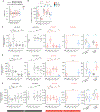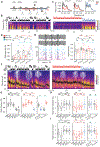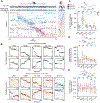Sleep loss diminishes hippocampal reactivation and replay
- PMID: 38867049
- PMCID: PMC11472378
- DOI: 10.1038/s41586-024-07538-2
Sleep loss diminishes hippocampal reactivation and replay
Abstract
Memories benefit from sleep1, and the reactivation and replay of waking experiences during hippocampal sharp-wave ripples (SWRs) are considered to be crucial for this process2. However, little is known about how these patterns are impacted by sleep loss. Here we recorded CA1 neuronal activity over 12 h in rats across maze exploration, sleep and sleep deprivation, followed by recovery sleep. We found that SWRs showed sustained or higher rates during sleep deprivation but with lower power and higher frequency ripples. Pyramidal cells exhibited sustained firing during sleep deprivation and reduced firing during sleep, yet their firing rates were comparable during SWRs regardless of sleep state. Despite the robust firing and abundance of SWRs during sleep deprivation, we found that the reactivation and replay of neuronal firing patterns was diminished during these periods and, in some cases, completely abolished compared to ad libitum sleep. Reactivation partially rebounded after recovery sleep but failed to reach the levels found in natural sleep. These results delineate the adverse consequences of sleep loss on hippocampal function at the network level and reveal a dissociation between the many SWRs elicited during sleep deprivation and the few reactivations and replays that occur during these events.
© 2024. The Author(s), under exclusive licence to Springer Nature Limited.
Conflict of interest statement
Competing Interests
The authors declare no competing interests.
Figures











Update of
-
Sleep loss diminishes hippocampal reactivation and replay.Res Sq [Preprint]. 2023 Feb 16:rs.3.rs-2540186. doi: 10.21203/rs.3.rs-2540186/v1. Res Sq. 2023. Update in: Nature. 2024 Jun;630(8018):935-942. doi: 10.1038/s41586-024-07538-2. PMID: 36824950 Free PMC article. Updated. Preprint.
References
-
- Girardeau G, Benchenane K, Wiener SI, Buzsaki G & Zugaro MB Selective suppression of hippocampal ripples impairs spatial memory. Nat Neurosci 12, 1222–1223 (2009). - PubMed
MeSH terms
Grants and funding
LinkOut - more resources
Full Text Sources
Miscellaneous

